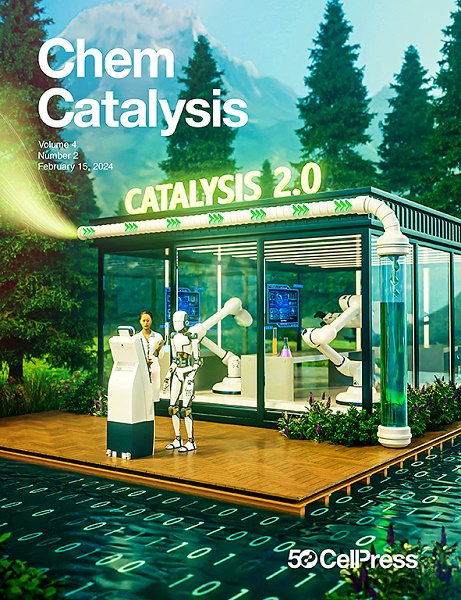空间不对称催化剂设计,具有富电子的Cu位点,促进全谱光芬顿催化
IF 11.6
Q1 CHEMISTRY, PHYSICAL
引用次数: 0
摘要
非均相光-Fenton催化是一种很有前途的高级氧化技术,但由于电子供应不足以维持Fenton反应,反应动力学缓慢。在这里,我们展示了一种基于不对称催化剂的硅酸铜纳米管(CSN) Janus设计,它同时具有良好的全光谱太阳能吸收、H2O2吸附和催化活性。配位不对称诱导了氧空位相关的富电子Cu(I)位和从Si-O向Cu- o亚层取向的本然电场,协同驱动光激发电子来补偿Cu位的给电子能力,从而显著增强H2O2活化。Cu(I)位点的强电子离域增强了H2O2在相邻桥接H位点上的吸附。H2O2解离能垒大大降低(0.912→0.264 eV),提高H2O2利用率(54%,几乎是传统催化剂的两倍)。csn催化的光- fenton -like反应可产生持久的·OH,对消除各类有机污染物具有优异的性能。本文章由计算机程序翻译,如有差异,请以英文原文为准。

Spatially asymmetric catalyst design with electron-rich Cu sites to facilitate full-spectrum photo-Fenton-like catalysis
Heterogeneous photo-Fenton catalysis stands out as a promising advanced oxidation technology but is subject to slow reaction kinetics because the electron supply is insufficient to sustain the Fenton reaction. Here, we demonstrate an asymmetric-catalyst-based copper silicate nanotube (CSN) Janus design that simultaneously enables favorable full-spectrum solar absorption, H2O2 adsorption, and catalytic activity. The coordination asymmetry induces oxygen-vacancy-associated, electron-rich Cu(I) sites and an intrinsic electric field oriented from the Si-O to the Cu-O sublayer, synergistically driving the photoexcited electrons to compensate for the electron-donating capability of Cu sites, leading to remarkably enhanced H2O2 activation. The strong electron delocalization of Cu(I) sites reinforces the H2O2 adsorption on its adjacent bridging H sites. The energy barrier for H2O2 dissociation is vastly reduced (0.912 → 0.264 eV), boosting H2O2 utilization (54%, almost two times higher than that of conventional catalysts). The CSN-catalyzed photo-Fenton-like reaction attains long-lasting ·OH production, which affords exceptional performance for various types of organic pollutant elimination.
求助全文
通过发布文献求助,成功后即可免费获取论文全文。
去求助
来源期刊
CiteScore
10.50
自引率
6.40%
发文量
0
期刊介绍:
Chem Catalysis is a monthly journal that publishes innovative research on fundamental and applied catalysis, providing a platform for researchers across chemistry, chemical engineering, and related fields. It serves as a premier resource for scientists and engineers in academia and industry, covering heterogeneous, homogeneous, and biocatalysis. Emphasizing transformative methods and technologies, the journal aims to advance understanding, introduce novel catalysts, and connect fundamental insights to real-world applications for societal benefit.

 求助内容:
求助内容: 应助结果提醒方式:
应助结果提醒方式:


